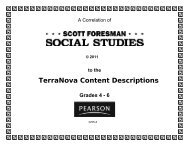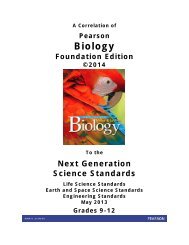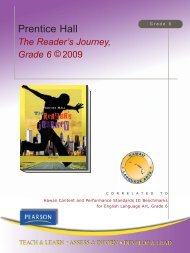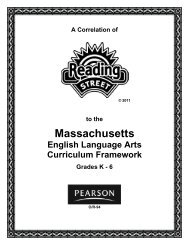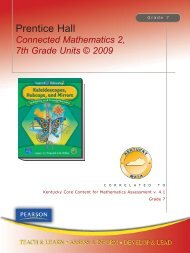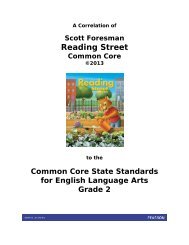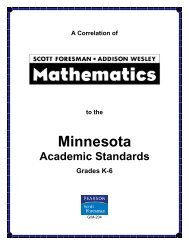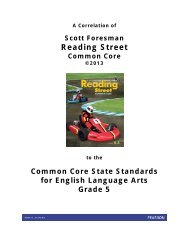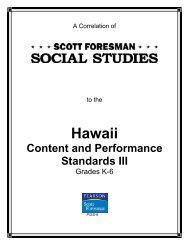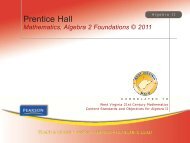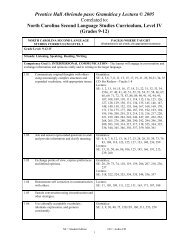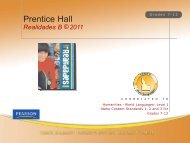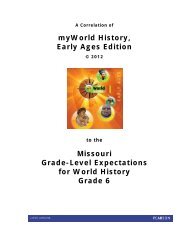Miller & Levine Biology - Pearson
Miller & Levine Biology - Pearson
Miller & Levine Biology - Pearson
You also want an ePaper? Increase the reach of your titles
YUMPU automatically turns print PDFs into web optimized ePapers that Google loves.
A Correlation of<strong>Miller</strong> & <strong>Levine</strong> <strong>Biology</strong>, ©2014to the Next Generation Science Standards, May 2013Grades 9-12Science and Engineering PracticesDeveloping and Using ModelsModeling in 9–12 builds on K–8 experiences andprogresses to using, synthesizing, and developing modelsto predict and show how relationships among variablesbetween systems and their components in the natural anddesigned worlds.•Develop a model based on evidence to illustrate therelationships between systems or components of asystem. (HS-LS2-5)TE: Summative Performance Task (p. 88)Using Mathematics and Computational ThinkingMathematical and computational thinking in 9-12 buildson K-8 experiences and progresses to using algebraicthinking and analysis, a range of linear and nonlinearfunctions including trigonometric functions, exponentialsand logarithms, and computational tools for statisticalanalysis to analyze, represent, and model data. Simplecomputational simulations are created and used based onmathematical models of basic assumptions.•Use mathematical and/or computationalrepresentations of phenomena or design solutions tosupport explanations. (HS-LS2-1)SE: Q1 (p. 147); Q31 (p. 150)TE: Use Visuals (p. 139)•Use mathematical representations of phenomena ordesign solutions to support and revise explanations. (HS-LS2-2)SE: Case Study #2 (p. 176); Analyzing Data(p. 184)•Use mathematical representations of phenomena ordesign solutions to support claims. (HS-LS2-4)SE: Analyzing Data (p. 77); Q2 (p. 78); Q2(p. 89); Q27 and Q28 (p. 92)TE: Differentiated Instruction (p. 77)Constructing Explanations and Designing SolutionsConstructing explanations and designing solutions in 9–12builds on K–8 experiences and progresses to explanationsand designs that are supported by multiple andindependent student-generated sources of evidenceconsistent with scientific ideas, principles, and theories.•Construct and revise an explanation based on validand reliable evidence obtained from a variety of sources(including students’ own investigations, models, theories,simulations, peer review) and the assumption thattheories and laws that describe the natural world operatetoday as they did in the past and will continue to do so inthe future. (HS-LS2-3)SE: Q13 (p. 90); Chapter 9 Mystery (pp. 249and 269)•Design, evaluate, and refine a solution to a complexreal-world problem, based on scientific knowledge,student-generated sources of evidence, prioritized criteria,and tradeoff considerations. (HS-LS2-7)Disciplinary Core IdeasLS2.A: Interdependent Relationships inEcosystems•Ecosystems have carrying capacities, which are limitsto the numbers of organisms and populations they cansupport. These limits result from such factors as theavailability of living and nonliving resources and from suchchallenges such as predation, competition, and disease.Organisms would have the capacity to producepopulations of great size were it not for the fact thatenvironments and resources are finite. This fundamentaltension affects the abundance (number of individuals) ofspecies in any given ecosystem. (HS-LS2-1),(HS-LS2-2)SE/TE: Competition (pp. 100–101);Exponential Growth (pp. 132–133); LogisticGrowth (pp. 134–135); Density-DependentLimiting Factors (pp. 138–140)LS2.B: Cycles of Matter and Energy Transfer inEcosystems•Photosynthesis and cellular respiration (includinganaerobic processes) provide most of the energy for lifeprocesses. (HS-LS2-3)SE/TE: Primary Producers (pp. 69–70);Energy and Life (pp. 226–228); ChemicalEnergy and Food (p. 250)•Plants or algae form the lowest level of the food web.At each link upward in a food web, only a small fraction ofthe matter consumed at the lower level is transferredupward, to produce growth and release energy in cellularrespiration at the higher level. Given this inefficiency,there are generally fewer organisms at higher levels of afood web. Some matter reacts to release energy for lifefunctions, some matter is stored in newly madestructures, and much is discarded. The chemical elementsthat make up the molecules of organisms pass throughfood webs and into and out of the atmosphere and soil,and they are combined and recombined in different ways.At each link in an ecosystem, matter and energy areconserved. (HS-LS2-4)SE/TE: Food Chains and Food Webs (pp.73–75); Trophic Levels and EcologicalPyramids (pp. 77–78); Recycling in theBiosphere (pp. 79–80); Nutrient Cycles (pp.82–85)•Photosynthesis and cellular respiration are importantcomponents of the carbon cycle, in which carbon isexchanged among the biosphere, atmosphere, oceans,and geosphere through chemical, physical, geological, andbiological processes. (HS-LS2-5)SE/TE: The Carbon Cycle (pp. 82–83)Crosscutting ConceptsCause and Effect•Empirical evidence is required to differentiate betweencause and correlation and make claims about specificcauses and effects. (HS-LS2-8)TE: How Science Works (p. 848)<strong>Biology</strong>.com: Chapter 29 STEM activity,Yellowstone WolvesScale, Proportion, and Quantity•The significance of a phenomenon is dependent on thescale, proportion, and quantity at which it occurs. (HS-LS2-1)SE: Analyzing Data (p. 150)TE: Connect to Math (p. 143)<strong>Biology</strong>.com: Chapter 3 Data Analysis,Counting on Nature•Using the concept of orders of magnitude allows oneto understand how a model at one scale relates to amodel at another scale. (HS-LS2-2)TE: Connect to Math (p. 133)Systems and System Models•Models (e.g., physical, mathematical, computermodels) can be used to simulate systems andinteractions—including energy, matter, and informationflows—within and between systems at different scales.(HS-LS2-5)SE: Figure 3–17 (p. 83)TE: Transfer Performance Task (p. 242)Energy and Matter•Energy cannot be created or destroyed—it only movesbetween one place and another place, between objectsand/or fields, or between systems. (HS-LS2-4)SE: Figure 3–5 (p. 70); Figure 3–6 (p. 71);Figure 3–11 (p. 77)TE: Address Misconceptions (p. 70); AddressMisconceptions (p. 82)•Energy drives the cycling of matter within and betweensystems. (HS-LS2-3)SE: Visual Analogy (p. 79); Q 26 (p. 92)TE: Build Background (p. 69); Quick Facts(p. 70)SE: Quick Lab (p. 155); Analyzing Data(p. 172); Q4 (p. 181); Unit 2 Project (pp.61a–61b)SE = Student Edition; TE = Teacher’s Edition; LMA = Lab Manual A 10



